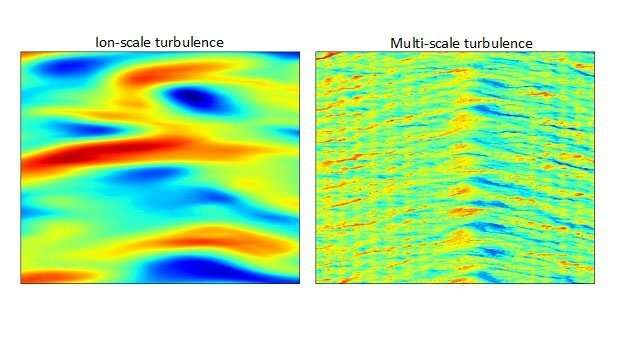Fusion simulations reveal the multi-scale nature of tokamak turbulence

Creating efficient, self-sustaining fusion power requires good confinement of the heat in the plasma. Plasma confinement is limited by particle and energy losses due to turbulence. A new analysis has used a powerful supercomputer to study this turbulence.
The study examined the complex interaction between the slow, large-scale motion of hydrogen fuel ions and the fast, small-scale motion of electrons. It found that this so-called “multi-scale turbulence” is mostly responsible for the heat losses in the edge region of tokamak experiments in the conditions required for an optimized fusion reactor.
The paper is published in the journal Plasma Physics and Controlled Fusion.
Previous simulations have focused on turbulence driven by the large-scale motion of hydrogen fuel ions. Recent advances in computing have enabled new simulations that can couple the space and time scales of hydrogen ions to the smaller spatial scales and faster time scales of the much lighter electrons. Hydrogen ions are 1800 times heavier than electrons.
In this study, using one of the most powerful computers in the world, the Summit supercomputer at the Oak Ridge Leadership Computing Facility, a Department of Energy user facility, scientists performed the first simulations of plasma turbulence in the edge of tokamaks that capture the multi-scale ion-electron interaction. The team included researchers from General Atomics and the University of California San Diego. The simulations accurately predict the heat losses measured in experiments in the DIII-D tokamak. The findings reveal that turbulence at small electron scales can become the dominant driver of heat loss in the tokamak edge.
Plasma turbulence can limit the performance of fusion reactors. Researchers know that the edge region of the tokamak plasma plays a key role in setting overall energy confinement. The new supercomputer simulations provide much-needed predictions of edge turbulence. This will aid fusion science researchers in designing next-generation fusion reactors like ITER with optimal fusion performance.
More information:
E A Belli et al, Spectral transition of multiscale turbulence in the tokamak pedestal, Plasma Physics and Controlled Fusion (2022). DOI: 10.1088/1361-6587/aca9fa
Citation:
Fusion simulations reveal the multi-scale nature of tokamak turbulence (2023, June 21)
retrieved 21 June 2023
from https://phys.org/news/2023-06-fusion-simulations-reveal-multi-scale-nature.html
This document is subject to copyright. Apart from any fair dealing for the purpose of private study or research, no
part may be reproduced without the written permission. The content is provided for information purposes only.
For all the latest Science News Click Here
For the latest news and updates, follow us on Google News.

